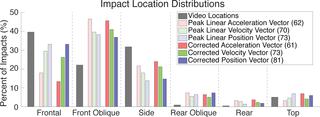PLOS ONE ( IF 3.7 ) Pub Date : 2018-06-19 , DOI: 10.1371/journal.pone.0199238 Calvin Kuo , Lyndia Wu , Jesus Loza , Daniel Senif , Scott C. Anderson , David B. Camarillo

|
Previous research has sought to quantify head impact exposure using wearable kinematic sensors. However, many sensors suffer from poor accuracy in estimating impact kinematics and count, motivating the need for additional independent impact exposure quantification for comparison. Here, we equipped seven collegiate American football players with instrumented mouthguards, and video recorded practices and games to compare video-based and sensor-based exposure rates and impact location distributions. Over 50 player-hours, we identified 271 helmet contact periods in video, while the instrumented mouthguard sensor recorded 2,032 discrete head impacts. Matching video and mouthguard real-time stamps yielded 193 video-identified helmet contact periods and 217 sensor-recorded impacts. To compare impact locations, we binned matched impacts into frontal, rear, side, oblique, and top locations based on video observations and sensor kinematics. While both video-based and sensor-based methods found similar location distributions, our best method utilizing integrated linear and angular position only correctly predicted 81 of 217 impacts. Finally, based on the activity timeline from video assessment, we also developed a new exposure metric unique to American football quantifying number of cross-verified sensor impacts per player-play. We found significantly higher exposure during games (0.35, 95% CI: 0.29–0.42) than practices (0.20, 95% CI: 0.17–0.23) (p<0.05). In the traditional impacts per player-hour metric, we observed higher exposure during practices (4.7) than games (3.7) due to increased player activity in practices. Thus, our exposure metric accounts for variability in on-field participation. While both video-based and sensor-based exposure datasets have limitations, they can complement one another to provide more confidence in exposure statistics.
中文翻译:

基于视频和基于传感器的头部撞击暴露的比较
先前的研究试图使用可穿戴运动学传感器来量化头部撞击的暴露。然而,许多传感器在估计冲击运动学和计数方面的准确性较差,因此需要进行额外的独立冲击暴露量化以进行比较。在这里,我们为七名大学美式橄榄球球员配备了器械护齿器,并录制了视频录制的做法和游戏,以比较基于视频和基于传感器的曝光率以及影响位置的分布。在超过50个游戏小时的时间内,我们在视频中确定了271个头盔接触时间段,而装备的护齿传感器记录了2,032个离散的头部撞击。匹配的视频和护齿实时戳记产生了193个视频识别头盔接触时间和217个传感器记录的撞击。为了比较碰撞的位置,我们将匹配的碰撞分为正面,背面,基于视频观察和传感器运动学的侧面,倾斜和顶部位置。虽然基于视频的方法和基于传感器的方法都可以找到相似的位置分布,但是我们利用集成线性和角度位置的最佳方法只能正确预测217次撞击中的81次。最后,根据视频评估的活动时间表,我们还开发了一种新的曝光指标,该指标是美式足球独有的,可以量化每个球员比赛经过交叉验证的传感器碰撞的数量。我们发现游戏期间的接触率(0.35,95%CI:0.29–0.42)明显高于练习(0.20,95%CI:0.17–0.23)(p <0.05)。在传统的每玩家小时影响指标中,我们观察到练习中的曝光率(4.7)比游戏中的(3.7)高,这是因为练习中的玩家活动增加了。因此,我们的暴露指标可说明现场参与的可变性。



























 京公网安备 11010802027423号
京公网安备 11010802027423号